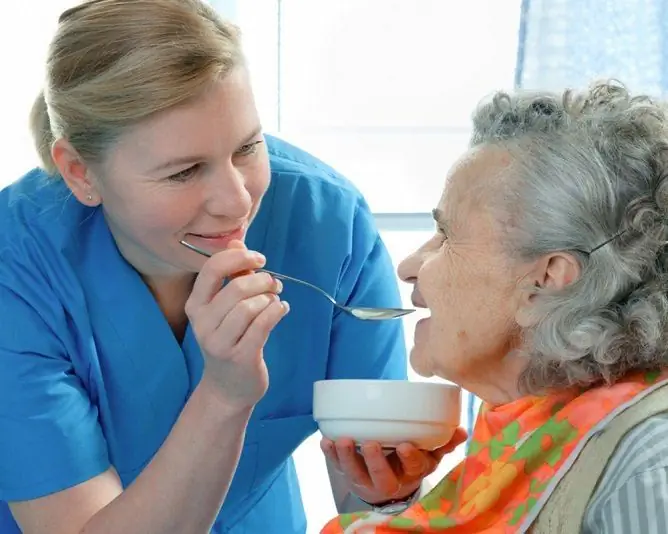- Author Rachel Wainwright [email protected].
- Public 2023-12-15 07:39.
- Last modified 2025-11-02 20:14.
Rehabilitation after myocardial infarction
The content of the article:
- What is post-infarction rehabilitation
- Where to get rehabilitation
- Rehabilitation at home
- Physical rehabilitation after a heart attack
- Principles of dietary nutrition after a heart attack
- Other recommendations for post-infarction rehabilitation
- Video
Rehabilitation after myocardial infarction and stenting includes a set of measures aimed at the fastest and most complete recovery of the body, namely, drug therapy, diet, physical activity, psychological assistance.
Myocardial infarction is a form of ischemic heart disease (IHD) that occurs when there is an acute disturbance of blood flow in the coronary arteries and leads to necrosis of areas of the heart tissue with a subsequent decrease in organ function.
Since the functions of the heart after the transferred patient are irretrievably disturbed, patients need long-term treatment, medical and social rehabilitation, during which the maximum possible restoration of the impaired functions and adaptation of the body to new conditions of existence is carried out. The main tasks of rehabilitation are to return to a normal lifestyle and prevent complications, including a second attack. Meanwhile, the risk of relapse is quite high, it is 20-40%, depending on the form of the disease.
What is post-infarction rehabilitation
The choice in favor of a particular rehabilitation program depends on the patient's condition, the severity of the disease, the presence of contraindications, the etiological factor and a number of other individual parameters. How long does postinfarction rehabilitation take? Usually six months, but this period can also vary depending on the severity of the disease. For example, a massive heart attack, more damaging the heart muscle, requires longer treatment and subsequent restorative measures. Therefore, the attending physician draws up a recovery plan in accordance with clinical guidelines, for each patient individually.

Post-infarction rehabilitation begins approximately 2-3 days after the attack
However, there are also some general recommendations. Proper nutrition, adequate physical activity, rejection of bad habits and other preventive measures are shown not only at all stages of rehabilitation, the patient should follow them for the rest of his life.
Where to get rehabilitation
Postinfarction and poststroke rehabilitation is started at the stage of the patient's stay in the hospital, after the stabilization of his condition. In this, the patient is under constant medical supervision, and regular monitoring of vital signs allows you to prescribe certain types of physical activity in a timely manner, control their effect on the body and adjust the load in accordance with the patient's condition.
After a heart attack, the patient is usually in the hospital for one to three weeks (depending on the severity of the disease). During this time, minimal physical skills are restored, a diet is selected, the doctor develops a recovery plan and provides recommendations to the patient and his family, if necessary, conducting their training.
In the future, as a rule, rehabilitation continues at home (outpatient stage). However, recovery can also take place in a specialized rehabilitation center, in a sanatorium or dispensary. A rehabilitation course in a specialized center that provides all the conditions for effective recovery under 24-hour medical supervision usually shows the best results.
Rehabilitation at home
Patients who have had a heart attack need the help of loved ones. First of all, they are protected from physical exertion, which in the future, as they recover, can be allowed, but should increase gradually, and some, involving heavy physical efforts, are prohibited for the entire period of rehabilitation. In addition, the patient should be protected from excessive psycho-emotional outbursts, surrounded by the care and attention of loved ones. It must be understood that rehabilitation will require effort and patience both from the patient himself and from his environment.
At home, it is necessary to continue the therapeutic measures prescribed by the doctor. This concerns the careful intake of medicines, careful adherence to the rules and diet, as well as the performance of therapeutic exercises, special exercises, which usually require several times a day for several minutes.
Patients undergoing rehabilitation at home need regular examinations by a cardiologist who monitors the progress of the body's recovery. This may require an electrocardiogram, echocardiogram, stress tests, laboratory blood tests and a number of other diagnostic techniques. Some of these can be done at home, for others the patient will need to visit a polyclinic.
Physical rehabilitation after a heart attack
An important part of rehabilitation is physiotherapy exercises (exercise therapy). Gymnastics should be started only after the permission of the attending physician. The time to start physical rehabilitation depends on the degree of damage to the heart muscle and the patient's condition. So, the average severity of the disease allows you to start physical rehabilitation in 2-3 days, and severe - not earlier than in a week.
A set of exercise therapy exercises is shown by a doctor or exercise therapy instructor. They are simple, at the initial stage the patient performs them under the supervision of a specialist, then independently. After exercise, the patient's blood pressure and pulse are measured. If the indicators are outside the normal range, the load is reduced, if not, they continue, gradually (in no case quickly) increasing the load.

Exercise therapy classes are conducted by an experienced instructor, monitoring blood pressure and pulse
An approximate plan for physical rehabilitation after a heart attack:
- in the first few days after the attack, the patient is shown strict bed rest;
- after 2-3 days it is allowed to slowly, using a support, take a sitting position, if the condition allows, they begin gymnastics;
- a week after the attack, the patient is allowed to walk short distances;
- from the second or third week, the patient is allowed slow walks in the fresh air, accompanied by an assistant.
The distance is slightly increased every day, making sure that during the walk the patient does not experience any discomfort (pain in the heart, shortness of breath, etc.).
In the future, after a favorable completion of rehabilitation, the patient may be recommended to other physical activities, for example, yoga, Pilates, walking, cycling, swimming.
Principles of dietary nutrition after a heart attack
For the purpose of the fastest and most complete recovery after myocardial infarction, as well as to prevent the development of complications, the patient is shown a diet. Basic rules for postinfarction dietary nutrition:
- Elimination of heavy and irritating foods from the diet.
- Significant salt restriction (no more than 5 g per day).
- The total amount of liquid is no more than 1.5 liters per day.
- Fractional meals - at least 5 meals a day in small portions.
- Inclusion in the diet of foods rich in fiber, vitamins, polyunsaturated fatty acids, microelements.
- Food should be boiled, steamed, stewed, baked. It is forbidden to fry in oil.
The diet should be based on lean meats, fish, seafood, fresh and thermally processed vegetables (with the exception of legumes, herbs, radishes, mushrooms), fruits and berries, dried fruits, vegetable oils, cereals, wholemeal bread, dairy and dairy products.
Alcohol in any form is strictly excluded. It is often possible to hear the opinion that doctors after a heart attack are advised by doctors to drink a small amount of alcohol daily - in some cases, cognac is mentioned, in others it is about red wine. This opinion has nothing to do with medical advice and is refuted by doctors. There are no recommended types or doses of alcohol for patients with myocardial infarction.
Other recommendations for post-infarction rehabilitation
In addition to alcohol, patients need to quit smoking. It has been found that tobacco smoking exposes the patient to a serious risk of cardiovascular disease, and in patients who have had a heart attack, the risk of relapse. In addition, you should avoid secondhand smoke, which has an equally harmful effect on the body in general and the cardiovascular system in particular.
During the rehabilitation period, as well as in the future, the patient is usually prescribed supportive drug therapy. It includes taking antiarrhythmic drugs, antihypertensive drugs, drugs that reduce blood viscosity, lower cholesterol in the blood, improve metabolism (antioxidants, vitamin complexes) and others, depending on the indications. In addition, physiotherapy methods of rehabilitation, massage, herbal medicine, breathing exercises, magnetotherapy, etc. can be used.
Weight correction is strongly recommended for overweight patients. However, it should be borne in mind that extreme low-calorie diets are contraindicated. Nutrition during the rehabilitation period plays an important role; it must be balanced and meet the body's needs for macro- and micronutrients. The optimal way to lose weight for patients recovering from a heart attack is fractional meals with a decrease in the daily caloric intake of 200-300 kcal from the age norm. This is enough to achieve a smooth decrease in body weight.

It is recommended to spend more time outdoors
In the recovery period, as well as in the future, the patient needs a full night's sleep and a reasonable mode of alternating activity and rest. Lack of sleep and overwork are one of the main factors of dysfunction of the cardiovascular system, along with physical inactivity and nutritional errors.
It is necessary to spend time in the fresh air every day.
Often, after a myocardial infarction, patients develop depressive conditions and other mental disorders. They can be associated both directly with circulatory disorders and with psychological reasons, for example, a violation of the usual way of life, dependence on others. Such patients and their relatives are advised to consult a psychotherapist or psychologist. The specialist will help to normalize mood, prevent the development of neurosis, solve problems with sleep, get rid of phobias - what creates emotional obstacles to returning to a full life.
It should be remembered that throughout the rehabilitation, as well as in the future, the patient must avoid psycho-emotional and physical overload.
For the period of post-infarction rehabilitation, patients become temporarily disabled. Subsequently, after the completion of rehabilitation measures, the patient's ability to work can be restored, limited or completely lost. The decision on a person's ability to perform this or that type of activity is made by a special commission, which, in case of meeting certain criteria, assigns the patient a disability group.
Video
We offer for viewing a video on the topic of the article.

Anna Aksenova Medical journalist About the author
Education: 2004-2007 "First Kiev Medical College" specialty "Laboratory Diagnostics".
Found a mistake in the text? Select it and press Ctrl + Enter.






